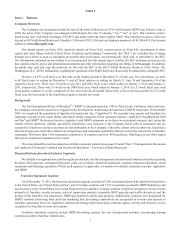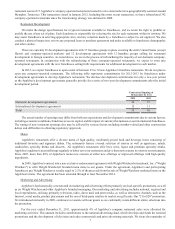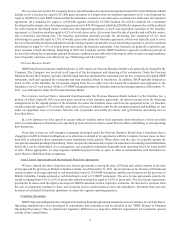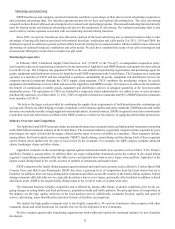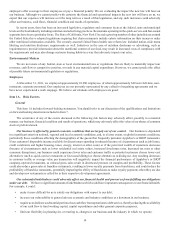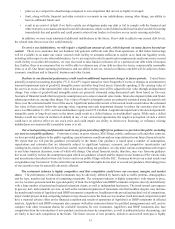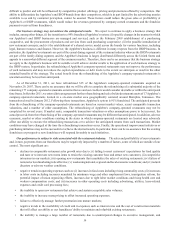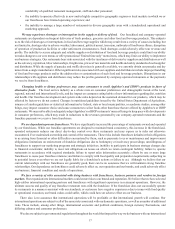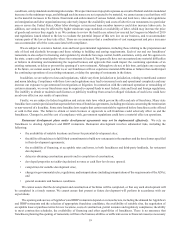IHOP 2011 Annual Report Download - page 30
Download and view the complete annual report
Please find page 30 of the 2011 IHOP annual report below. You can navigate through the pages in the report by either clicking on the pages listed below, or by using the keyword search tool below to find specific information within the annual report.
12
Marketing and Advertising
IHOP franchisees and company-operated restaurants contribute a percentage of their sales to local advertising cooperatives
and a national advertising fund. The franchise agreements provide for local and national advertising fees. The local advertising
cooperatives have historically used advertising fees for various local marketing programs. The national marketing fund is primarily
used for buying media and national advertising and also for the production of advertising. The national marketing fund is also
used to defray certain expenses associated with our marketing and advertising functions.
Since 2005, we and our franchisees have allocated a portion of the local advertising fees to national media in order to take
advantage of buying efficiencies associated with national broadcast, syndication and cable media. For 2011, 2010 and 2009, the
franchisees agreed to reallocate a greater portion of their local advertising fees to national media, which resulted in more television
advertising on national broadcast, syndication and cable media. We also have expanded the scope of our gift card program and
increased our third-party retailer base to market our gift cards.
Purchasing Cooperative
In February 2009, Centralized Supply Chain Services, LLC ("CSCS" or the "Co-op"), an independent cooperative entity,
was formed to operate as a purchasing cooperative for the operators of Applebee's and IHOP domestic restaurants who have chosen
to join the Co-op. The Company has appointed CSCS as the sole authorized purchasing organization and purchasing agent for
goods, equipment and distribution services for Applebee's and IHOP restaurants in the United States. The Company (as a restaurant
operator) is a member of CSCS and has committed to purchase substantially all goods, equipment and distribution services for
company-operated restaurants through the CSCS supply chain program. CSCS combines the purchasing volume for goods,
equipment and distribution services within and across the Applebee's and IHOP concepts. Its mission is to achieve for its members
the benefit of continuously available goods, equipment and distribution services in adequate quantities at the lowest possible
sustainable prices. The operations of CSCS are funded by a separately stated administrative fee added to one or more products
purchased by operators. As of December 31, 2011, 100% of Applebee's franchise restaurants and 96% of IHOP franchise restaurants
were members of CSCS.
We believe the larger scale provided by combining the supply chain requirements of both brands provides continuing cost
savings and efficiencies while helping to ensure compliance with Company quality and safety standards. IHOP pancake and waffle
dry mixes are manufactured by a single supplier from multiple plants. In some instances, IHOP is required to enter into commitments
to purchase food and other items on behalf of the IHOP system as a whole for the purpose of supplying limited time promotions.
Industry Overview and Competition
The Applebee's and IHOP restaurant chains are among the numerous restaurant chains and independent restaurants competing
in the $600 billion restaurant industry in the United States. The restaurant industry is generally categorized into segments by price
point ranges, the types of food and beverages offered and the types of service available to consumers. These segments include,
among others, fast food or quick service restaurants ("QSR"), family dining, casual dining and fine dining. Each of these segments
can be broken down further into the type of food served by the restaurant. For example, the QSR category includes sandwich
chains, hamburger chains and other chains.
Applebee's competes in the casual dining segment against national and multi-state operators such as Chili's, T.G.I. Friday's
and Ruby Tuesday's, among others. In addition, there are many independent restaurants across the country in the casual dining
segment. Casual dining restaurants offer full table service and typically have bars or serve liquor, wine and beer. Applebee's is the
largest casual dining brand in the world, in terms of number of restaurants and market share.
IHOP competes in the family dining segment against national and multi-state operators such as Denny's, Cracker Barrel Old
Country Store and Bob Evans Restaurants. IHOP also faces a growing level of competition from fast food chains that serve
breakfast. In addition, there are many independent restaurants and diners across the country in the family dining segment. Family
dining restaurants offer full table service, typically do not have bars or serve liquor, and usually offer breakfast in addition to lunch
and dinner items. IHOP is the largest family dining brand in the world in terms of system-wide sales.
The restaurant business is highly competitive and is affected by, among other things, economic conditions, price levels, on-
going changes in eating habits and food preferences, population trends and traffic patterns. The principal bases of competition in
the industry are the type, quality and price of the food products served. Additionally, restaurant location, quality and speed of
service, advertising, name identification and attractiveness of facilities are important.
The market for high quality restaurant sites is also highly competitive. We and our franchisees often compete with other
restaurant chains and retail businesses for suitable sites for the development of new restaurants.
We also compete against other franchising organizations both within and outside the restaurant industry for new franchise
developers.



